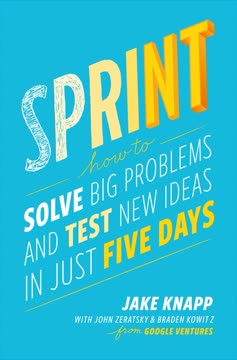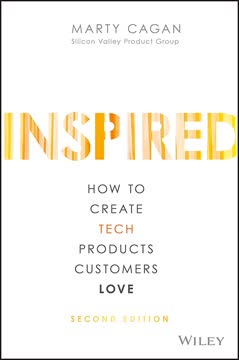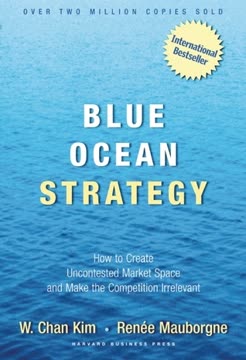つの重要なポイント
1. デザイン思考は問題解決とイノベーションのための体系的アプローチである
デザイン思考は、TQMが品質に対して行ったことを有機的成長とイノベーションに対して行うことができる。つまり、常に関心を持っていたことに対して、マネージャーが実現するためのツールとプロセスを提供するのである。
デザイン思考の解明。 デザイン思考は魔法でもデザイナー専用のものでもない。それはすべてのマネージャーが利用できる体系的な問題解決アプローチである。顧客を深く理解し、彼らのためにより良い未来を創造することから始まり、最初の試みが完璧でないことを認識する。
デザイン思考の主要原則:
- 共感: 顧客のニーズと経験を深く理解する
- 発明: そのニーズを満たす新しい解決策を創造する
- 繰り返し: フィードバックと学習に基づいてアイデアを継続的に洗練する
デザイン思考は従来のビジネス分析を補完し、人間中心の創造的アプローチをイノベーションに取り入れる。これにより、マネージャーは漸進的な改善を超えて、画期的な成長機会を創出することができる。
2. デザインプロセスは「現状は?」「もしも?」「驚きは?」「実行可能か?」の4つの重要な質問に従う
デザインは共感から始まり、デザイン対象者を深く理解することから始まる。
4つの質問のフレームワーク。 デザイン思考プロセスは、各段階が重要な質問に焦点を当てた4つの主要なステージに分けられる。
- 現状は? - 現実を探求し理解する
- もしも? - 新しい可能性と代替案を想像する
- 驚きは? - 最も有望なコンセプトを特定する
- 実行可能か? - アイデアを現実世界でテストし洗練する
このフレームワークは、問題領域を徹底的に探求し、解決策に飛びつく前にイノベーションプロジェクトの明確なロードマップを提供する。発散的思考(多くの選択肢を生成する)と収束的思考(最良のアイデアに絞り込む)をバランスよく取り入れている。
3. ビジュアライゼーションとジャーニーマッピングは深い顧客洞察を提供する
ジャーニーマッピングは、観察とインタビューを通じて収集されたデータを用いて、顧客の現在の体験を導く。
顧客の目を通して見る。 ビジュアライゼーション技術は、顧客体験に関する複雑な情報をチームが捉え、伝えるのに役立つ。特にジャーニーマッピングは、感情の高低を含む顧客全体の体験を理解するための強力なツールである。
主要なビジュアライゼーション技術:
- カスタマージャーニーマップ
- ペルソナ
- エンパシーマップ
- ストーリーボード
- 写真とビデオのエスノグラフィー
これらのツールは、チームが顧客に対する共感を育み、痛点や機会を特定し、組織内で洞察を効果的に伝えるのに役立つ。これにより、後の段階での革新的な思考を促進する共有理解が得られる。
4. ブレインストーミングとコンセプト開発は革新的な解決策を生み出す
新しいコンセプトの創造は、創造性よりもむしろ規律に依存する。
構造化された発想。 効果的なブレインストーミングには、自由なアイデア生成以上のものが必要である。慎重な準備、明確なルール、アイデアを捉え構築するための構造化されたアプローチが求められる。
成功するブレインストーミングの主要要素:
- 多様なチーム構成
- 明確な問題設定
- 思考を刺激するトリガー質問
- 他人のアイデアを基に構築する
- 初期段階では量を重視する
コンセプト開発は、ブレインストーミングの生の出力を一貫した、完全な解決策のコンセプトに変える。これには、関連するアイデアをクラスタリングし、テーマを特定し、要素を組み合わせて設計基準に対して評価できる堅牢な提案を作成することが含まれる。
5. 仮説検証と迅速なプロトタイピングはアイデアを効率的に洗練する
プロトタイピングは、学習の価値を計算する手頃な損失計算を使用する。
速く安く学ぶ。 仮説検証は、新しいコンセプトを成功させるかどうかを左右する重要な未知数を特定するのに役立つ。仮説を明示的に述べ、それをテストする実験を設計することで、チームは大きなリソースを投資する前にアイデアを迅速に検証または無効化できる。
迅速なプロトタイピングは、コンセプトを迅速かつ低コストで具現化する。主要な原則には以下が含まれる:
- シンプルに始める(例:紙のプロトタイプ)
- 完璧さではなく学習に焦点を当てる
- フィードバックに基づいて迅速に繰り返す
- 全体のコンセプトだけでなく特定の要素をテストする
このアプローチにより、チームは複数のオプションを探求し、迅速に失敗し、現実世界のフィードバックに基づいてアイデアを洗練することができ、後の段階での大規模な失敗のリスクを大幅に軽減する。
6. 顧客共創と学習ローンチは市場でコンセプトを検証する
未知のコンセプトを導入する際には、大部分が間違っていると予想される。だからこそ、低コスト、低忠実度のプロトタイプを使用した共創が、リスクを減らし、成功するイノベーションの速度を向上させるために非常に重要である。
顧客との協力。 共創は、新しい提供物の開発に潜在的な顧客を巻き込むことを意味する。この協力的なアプローチにより、解決策が真に顧客のニーズを満たし、プロセスの早い段階での賛同を得ることができる。
学習ローンチは、有望なコンセプトを市場に投入し、現実世界でテストする。主要な原則:
- 明確な学習目標を設定する
- 成功指標を事前に定義する
- 時間、地理、または顧客セグメントを制約する
- 迅速なフィードバックサイクルを設計する
- 結果に基づいて繰り返しまたはピボットする準備をする
これらのアプローチは、コンセプトと本格的なローンチの間のギャップを埋め、主要な投資が行われる前に、進行/中止の意思決定を情報に基づいて行い、提供物を洗練するための貴重なデータを提供する。
7. デザイン思考の実装には慎重なチーム選定とモメンタム管理が必要である
プロジェクトが順調に進み、人々が生産的だと感じる限り、ポジティブな雰囲気が生まれる。モメンタムを築くための最も重要な要素はスピードである。
成功のための構築。 組織にデザイン思考を実装するには、ツールとプロセスを学ぶだけでなく、チーム構成、プロジェクト選定、モメンタムの維持に細心の注意を払う必要がある。
成功する実装のための主要な考慮事項:
- 管理可能なプロジェクトから小さく始める
- 多様でクロスファンクショナルなチームを選定する
- 経営陣の支援を確保する
- 専用のプロジェクトスペース(「戦争室」)を作成する
- 定期的なチェックインと明確な意思決定プロセスを確立する
- 小さな成功を祝うとともに失敗から学ぶ
これらの要素に焦点を当てることで、組織はデザイン思考が繁栄する環境を作り出し、持続的なイノベーションと成長を実現することができる。
最終更新日:
FAQ
What's "Designing for Growth" about?
- Design Thinking for Managers: "Designing for Growth" by Jeanne Liedtka and Tim Ogilvie is a guide for managers on how to apply design thinking to drive business growth.
- Toolkit Approach: The book provides a toolkit of ten design thinking tools that managers can use to innovate and solve complex business problems.
- Structured Process: It outlines a structured process involving four key questions: What is? What if? What wows? and What works? to guide managers through the design thinking journey.
- Practical Examples: The book includes real-world examples and case studies to illustrate how design thinking can be applied in various business contexts.
Why should I read "Designing for Growth"?
- Practical Application: It offers practical tools and methods that managers can directly apply to their work to foster innovation and growth.
- Structured Framework: The book provides a clear, structured framework for implementing design thinking, making it accessible even to those new to the concept.
- Real-World Success Stories: It includes success stories from companies like AARP and Kaiser Permanente, demonstrating the effectiveness of design thinking in real business scenarios.
- Enhance Problem-Solving Skills: Reading this book can enhance your problem-solving skills by teaching you how to approach challenges creatively and strategically.
What are the key takeaways of "Designing for Growth"?
- Four Key Questions: The design thinking process is structured around four questions: What is? What if? What wows? and What works? These guide the exploration, ideation, and implementation phases.
- Ten Essential Tools: The book introduces ten tools, such as journey mapping and rapid prototyping, that are essential for applying design thinking in business.
- Customer-Centric Approach: Emphasizes the importance of understanding customer needs and involving them in the design process to create value.
- Iterative Learning: Encourages an iterative approach to innovation, where assumptions are tested and refined through prototypes and customer feedback.
How does "Designing for Growth" define design thinking?
- Systematic Approach: Design thinking is defined as a systematic approach to problem-solving that starts with understanding customer needs and creating a better future for them.
- Empathy, Invention, Iteration: It involves empathy for the user, invention of new solutions, and iteration to refine those solutions.
- Beyond Aesthetics: The book differentiates design thinking from traditional design by focusing on business growth and problem-solving rather than just aesthetics.
- Accessible to Managers: It argues that design thinking can be taught to managers and applied in business contexts to drive innovation.
What are the four key questions in "Designing for Growth"?
- What is?: This question focuses on understanding the current reality and identifying the real problem or opportunity.
- What if?: This stage involves envisioning new possibilities and generating creative ideas for the future.
- What wows?: Here, the focus is on selecting the most promising ideas that have the potential to create significant value.
- What works?: This final stage involves testing the ideas in the marketplace to see which ones are viable and can be scaled.
What are the ten tools of design thinking in "Designing for Growth"?
- Visualization: Using imagery to envision possibilities and bring them to life.
- Journey Mapping: Assessing the existing experience through the customer's eyes.
- Value Chain Analysis: Evaluating the current value chain that supports the customer's journey.
- Mind Mapping: Generating insights from exploration activities and creating design criteria.
- Brainstorming: Generating new possibilities and alternative business models.
- Concept Development: Assembling innovative elements into a coherent solution.
- Assumption Testing: Isolating and testing key assumptions that will drive success.
- Rapid Prototyping: Expressing a new concept in a tangible form for exploration.
- Customer Co-Creation: Involving customers in creating the solution that best meets their needs.
- Learning Launch: Creating an affordable experiment to test key assumptions with market data.
How does "Designing for Growth" suggest using visualization?
- Mother of All Tools: Visualization is considered a fundamental tool used in every stage of the design thinking process.
- Reduces Misinterpretation: It helps reduce project risk by making ideas tangible and reducing the chances of misinterpretation.
- Engages Right Brain: Visualization engages the right brain, which is responsible for emotion and intuition, aiding in decision-making.
- Various Forms: It can take many forms, including storyboards, sketches, and personas, to help communicate ideas effectively.
What is journey mapping according to "Designing for Growth"?
- Customer Experience Focus: Journey mapping is about representing the customer's experience in a flowchart or graphic format.
- Identifies Pain Points: It helps identify emotional highs and lows in the customer's journey, revealing opportunities for improvement.
- Empathy Building: By walking in the customer's shoes, it builds empathy and a deeper understanding of their needs.
- Foundation for Innovation: It serves as a foundation for generating innovative ideas that enhance the customer experience.
How does "Designing for Growth" recommend conducting brainstorming?
- Structured Process: Brainstorming should be a structured process with clear ground rules to encourage creativity and prevent critiques.
- Diverse Group: Involves a small, diverse group of people to bring in different perspectives and ideas.
- Trigger Questions: Uses trigger questions to stimulate creative thinking and explore new possibilities.
- Follow-Up: Emphasizes the importance of follow-up to convert raw ideas into robust concepts through concept development.
What is assumption testing in "Designing for Growth"?
- Key Assumptions: Assumption testing involves identifying and testing the key assumptions underlying a new business concept.
- Thought Experiments: It uses thought experiments to test assumptions with existing data before moving to market tests.
- Reduces Risk: By focusing on critical assumptions, it reduces the risk of failure by ensuring that only viable concepts move forward.
- Iterative Process: It is an iterative process that helps refine concepts and improve their chances of success.
How does "Designing for Growth" define rapid prototyping?
- Express Concepts: Rapid prototyping is about creating visual or experiential manifestations of concepts to test and refine them.
- Iterative Learning: It is an iterative process that allows for quick learning and refinement of ideas.
- Low-Fidelity Start: Prototypes start as low-fidelity models to invite feedback and collaboration from stakeholders.
- Minimizes Investment: By testing concepts early, it minimizes investment and risk before full-scale development.
What are the best quotes from "Designing for Growth" and what do they mean?
- "Design thinking is actually a systematic approach to problem solving." This quote emphasizes that design thinking is not just about creativity but involves a structured process to address business challenges.
- "Empathy, invention, and iteration." These three words capture the essence of design thinking, highlighting the importance of understanding users, creating new solutions, and refining them through feedback.
- "Fail fast to succeed sooner." This quote underscores the value of rapid prototyping and learning from failures quickly to achieve success in innovation.
- "Visualization is the mother of all design tools." It highlights the critical role of visualization in making ideas tangible and facilitating communication and collaboration.
レビュー
本書『Designing for Growth』は賛否両論の評価を受けており、平均評価は5点満点中3.99点である。読者はその視覚的な魅力とデザイン思考の概念の紹介を評価し、初心者にとって有用であると感じている。実践的なツールやケーススタディを称賛する声もある一方で、表面的な説明や専門家にとっての深みの欠如を批判する意見もある。本書の構成や整理されたアウトラインは概ね好評である。しかし、一部の読者は内容が繰り返しであり、過度に企業向けであると感じている。非英語版の翻訳品質については頻繁に批判が寄せられている。総じて、デザイン思考に初めて触れる人々にとっては良い入門書と見なされている。
Similar Books














